Recruitment and Selection Process Analysis
VerifiedAdded on 2020/01/28
|18
|6511
|489
Literature Review
AI Summary
This assignment delves into the complexities of recruitment and selection processes. Students are tasked with analyzing the effectiveness of these processes, particularly in mitigating staff turnover. The analysis should encompass best practices, the influence of training on employee performance, and the challenges associated with implementing effective HR strategies, such as addressing workplace bullying. The assignment draws upon a provided set of scholarly articles and online resources to support the analysis.
Contribute Materials
Your contribution can guide someone’s learning journey. Share your
documents today.

Human Resource
Management
Management
Secure Best Marks with AI Grader
Need help grading? Try our AI Grader for instant feedback on your assignments.

TABLE OF CONTENTS
INTRODUCTION...........................................................................................................................1
TASK 1............................................................................................................................................1
A) Purpose of workforce planning and role of HR manager.....................................................1
B) Strengths and weaknesses of recruitment and selection (R&S) approaches..........................1
C) Functions of HRM assist in gaining skilled and talented workforce.....................................2
D) Evaluating Strengths and weaknesses of different approaches of R&S................................3
E) Critical evaluation of the two R&S approaches.....................................................................3
TASK 2............................................................................................................................................3
A) Job advertisement...................................................................................................................3
B) Suitable platforms to place advertisement.............................................................................4
C) Job/ person specification........................................................................................................4
D) Rationale for the applications of specific HRM practices.....................................................5
TASK 3............................................................................................................................................6
A) Difference between training and development......................................................................6
B) Effects of changing customer preferences.............................................................................6
C) Training methods adopted by Tesco......................................................................................7
d) Way to identify training needs................................................................................................7
e) Benefits for Tesco and the employees in providing a structured training programme...........8
f) Extent to which training has achieved Return on Investment.................................................9
g) Types of approaches to flexibility that can be adopted by Tesco to aid its expansion of the
business.......................................................................................................................................9
M3 Different methods used by Tesco in developing employees and considering the strengths
and weaknesses of such a programme......................................................................................10
D2 Critically evaluate HRM practices within TESCO.............................................................10
TASK 4..........................................................................................................................................10
A) Importance of good employee relation and its influence on HR practices..........................10
B) Key elements in employment legislation.............................................................................11
c) Key aspects of employee relations management and employment legislation that affect
HRM decision-making in ITV..................................................................................................12
D3 Critically evaluate employee relations and the application of HRM practices in ITV that
inform and influence decision-making in the organisation.......................................................12
CONCLUSION..............................................................................................................................13
REFERENCES..............................................................................................................................14
INTRODUCTION...........................................................................................................................1
TASK 1............................................................................................................................................1
A) Purpose of workforce planning and role of HR manager.....................................................1
B) Strengths and weaknesses of recruitment and selection (R&S) approaches..........................1
C) Functions of HRM assist in gaining skilled and talented workforce.....................................2
D) Evaluating Strengths and weaknesses of different approaches of R&S................................3
E) Critical evaluation of the two R&S approaches.....................................................................3
TASK 2............................................................................................................................................3
A) Job advertisement...................................................................................................................3
B) Suitable platforms to place advertisement.............................................................................4
C) Job/ person specification........................................................................................................4
D) Rationale for the applications of specific HRM practices.....................................................5
TASK 3............................................................................................................................................6
A) Difference between training and development......................................................................6
B) Effects of changing customer preferences.............................................................................6
C) Training methods adopted by Tesco......................................................................................7
d) Way to identify training needs................................................................................................7
e) Benefits for Tesco and the employees in providing a structured training programme...........8
f) Extent to which training has achieved Return on Investment.................................................9
g) Types of approaches to flexibility that can be adopted by Tesco to aid its expansion of the
business.......................................................................................................................................9
M3 Different methods used by Tesco in developing employees and considering the strengths
and weaknesses of such a programme......................................................................................10
D2 Critically evaluate HRM practices within TESCO.............................................................10
TASK 4..........................................................................................................................................10
A) Importance of good employee relation and its influence on HR practices..........................10
B) Key elements in employment legislation.............................................................................11
c) Key aspects of employee relations management and employment legislation that affect
HRM decision-making in ITV..................................................................................................12
D3 Critically evaluate employee relations and the application of HRM practices in ITV that
inform and influence decision-making in the organisation.......................................................12
CONCLUSION..............................................................................................................................13
REFERENCES..............................................................................................................................14
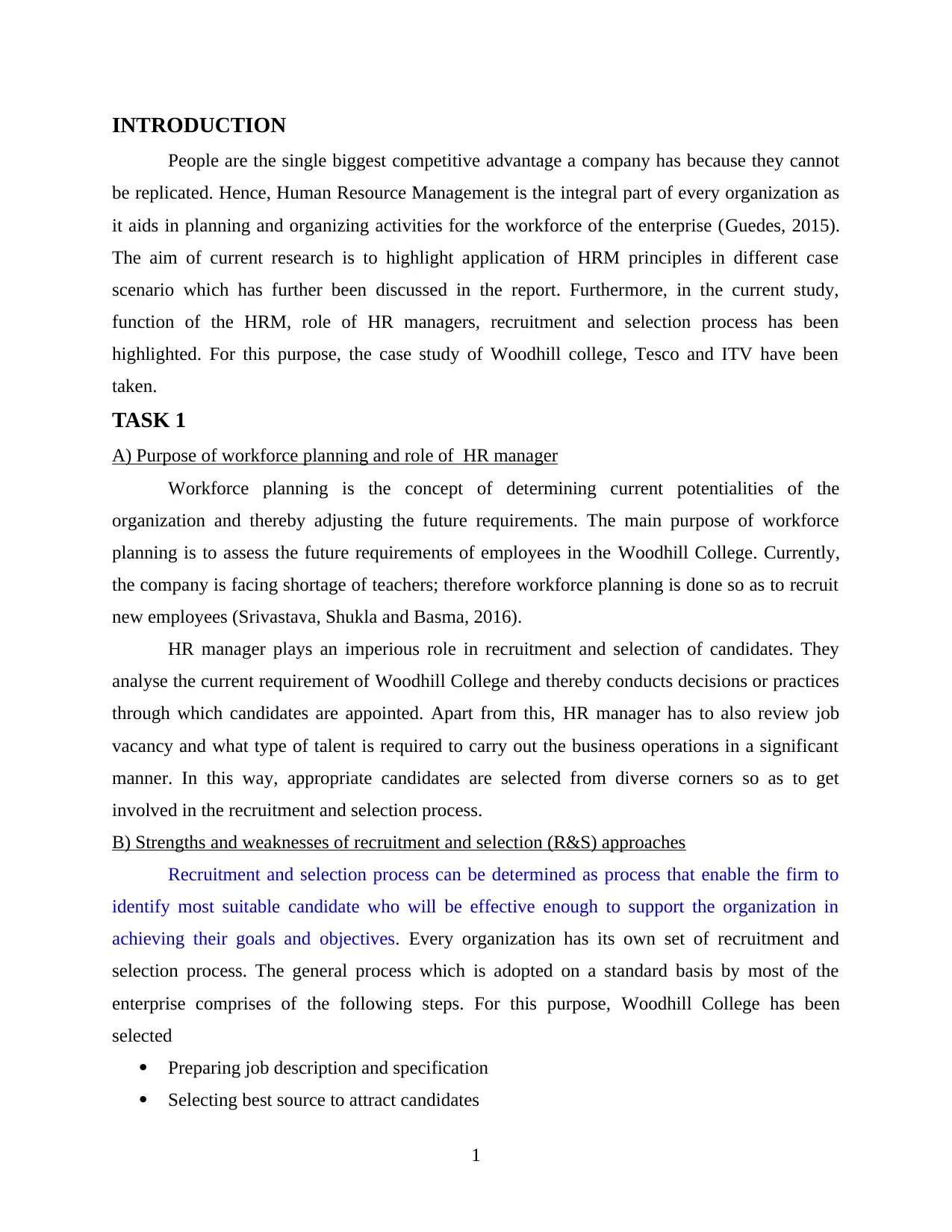
INTRODUCTION
People are the single biggest competitive advantage a company has because they cannot
be replicated. Hence, Human Resource Management is the integral part of every organization as
it aids in planning and organizing activities for the workforce of the enterprise (Guedes, 2015).
The aim of current research is to highlight application of HRM principles in different case
scenario which has further been discussed in the report. Furthermore, in the current study,
function of the HRM, role of HR managers, recruitment and selection process has been
highlighted. For this purpose, the case study of Woodhill college, Tesco and ITV have been
taken.
TASK 1
A) Purpose of workforce planning and role of HR manager
Workforce planning is the concept of determining current potentialities of the
organization and thereby adjusting the future requirements. The main purpose of workforce
planning is to assess the future requirements of employees in the Woodhill College. Currently,
the company is facing shortage of teachers; therefore workforce planning is done so as to recruit
new employees (Srivastava, Shukla and Basma, 2016).
HR manager plays an imperious role in recruitment and selection of candidates. They
analyse the current requirement of Woodhill College and thereby conducts decisions or practices
through which candidates are appointed. Apart from this, HR manager has to also review job
vacancy and what type of talent is required to carry out the business operations in a significant
manner. In this way, appropriate candidates are selected from diverse corners so as to get
involved in the recruitment and selection process.
B) Strengths and weaknesses of recruitment and selection (R&S) approaches
Recruitment and selection process can be determined as process that enable the firm to
identify most suitable candidate who will be effective enough to support the organization in
achieving their goals and objectives. Every organization has its own set of recruitment and
selection process. The general process which is adopted on a standard basis by most of the
enterprise comprises of the following steps. For this purpose, Woodhill College has been
selected
Preparing job description and specification
Selecting best source to attract candidates
1
People are the single biggest competitive advantage a company has because they cannot
be replicated. Hence, Human Resource Management is the integral part of every organization as
it aids in planning and organizing activities for the workforce of the enterprise (Guedes, 2015).
The aim of current research is to highlight application of HRM principles in different case
scenario which has further been discussed in the report. Furthermore, in the current study,
function of the HRM, role of HR managers, recruitment and selection process has been
highlighted. For this purpose, the case study of Woodhill college, Tesco and ITV have been
taken.
TASK 1
A) Purpose of workforce planning and role of HR manager
Workforce planning is the concept of determining current potentialities of the
organization and thereby adjusting the future requirements. The main purpose of workforce
planning is to assess the future requirements of employees in the Woodhill College. Currently,
the company is facing shortage of teachers; therefore workforce planning is done so as to recruit
new employees (Srivastava, Shukla and Basma, 2016).
HR manager plays an imperious role in recruitment and selection of candidates. They
analyse the current requirement of Woodhill College and thereby conducts decisions or practices
through which candidates are appointed. Apart from this, HR manager has to also review job
vacancy and what type of talent is required to carry out the business operations in a significant
manner. In this way, appropriate candidates are selected from diverse corners so as to get
involved in the recruitment and selection process.
B) Strengths and weaknesses of recruitment and selection (R&S) approaches
Recruitment and selection process can be determined as process that enable the firm to
identify most suitable candidate who will be effective enough to support the organization in
achieving their goals and objectives. Every organization has its own set of recruitment and
selection process. The general process which is adopted on a standard basis by most of the
enterprise comprises of the following steps. For this purpose, Woodhill College has been
selected
Preparing job description and specification
Selecting best source to attract candidates
1
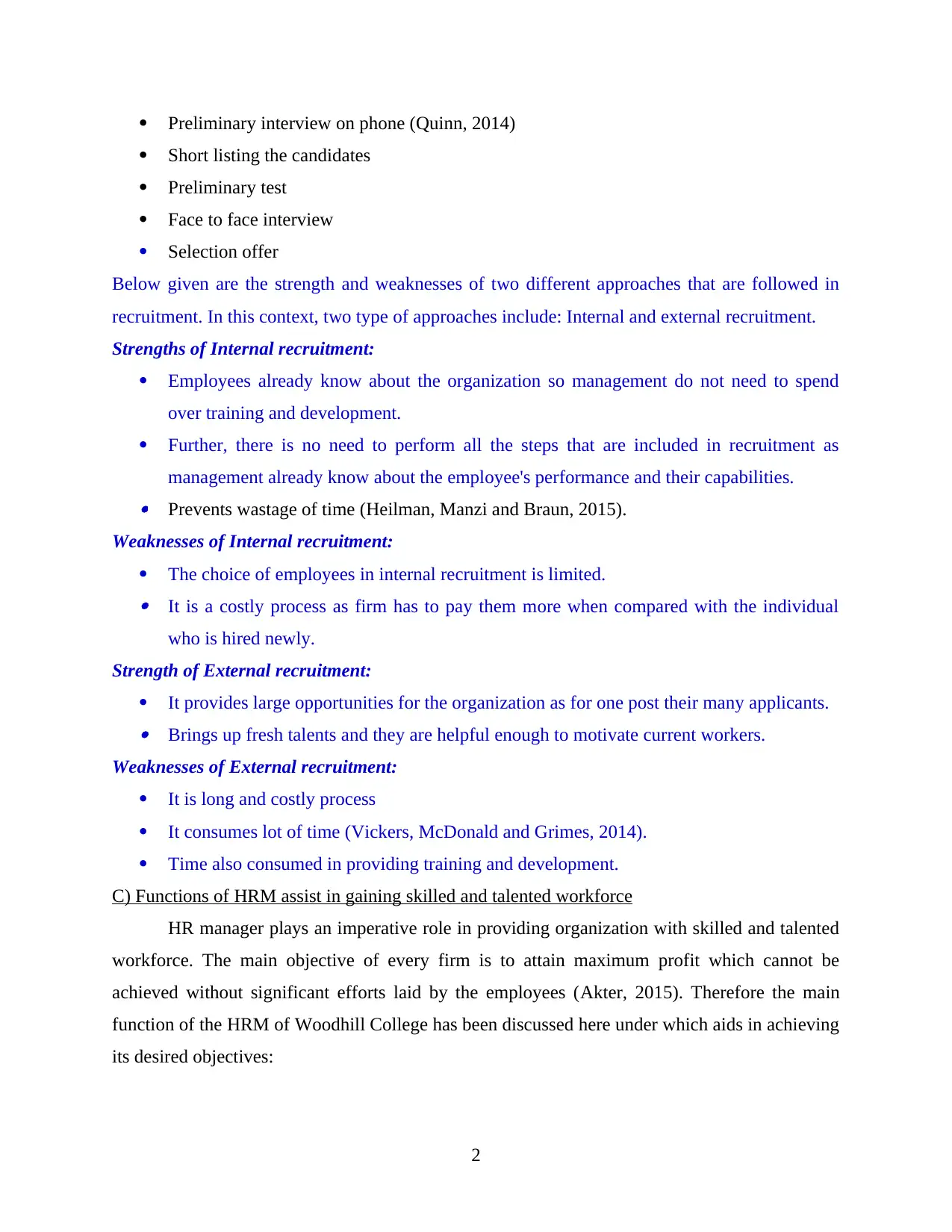
Preliminary interview on phone (Quinn, 2014)
Short listing the candidates
Preliminary test
Face to face interview
Selection offer
Below given are the strength and weaknesses of two different approaches that are followed in
recruitment. In this context, two type of approaches include: Internal and external recruitment.
Strengths of Internal recruitment:
Employees already know about the organization so management do not need to spend
over training and development.
Further, there is no need to perform all the steps that are included in recruitment as
management already know about the employee's performance and their capabilities. Prevents wastage of time (Heilman, Manzi and Braun, 2015).
Weaknesses of Internal recruitment:
The choice of employees in internal recruitment is limited. It is a costly process as firm has to pay them more when compared with the individual
who is hired newly.
Strength of External recruitment:
It provides large opportunities for the organization as for one post their many applicants. Brings up fresh talents and they are helpful enough to motivate current workers.
Weaknesses of External recruitment:
It is long and costly process
It consumes lot of time (Vickers, McDonald and Grimes, 2014).
Time also consumed in providing training and development.
C) Functions of HRM assist in gaining skilled and talented workforce
HR manager plays an imperative role in providing organization with skilled and talented
workforce. The main objective of every firm is to attain maximum profit which cannot be
achieved without significant efforts laid by the employees (Akter, 2015). Therefore the main
function of the HRM of Woodhill College has been discussed here under which aids in achieving
its desired objectives:
2
Short listing the candidates
Preliminary test
Face to face interview
Selection offer
Below given are the strength and weaknesses of two different approaches that are followed in
recruitment. In this context, two type of approaches include: Internal and external recruitment.
Strengths of Internal recruitment:
Employees already know about the organization so management do not need to spend
over training and development.
Further, there is no need to perform all the steps that are included in recruitment as
management already know about the employee's performance and their capabilities. Prevents wastage of time (Heilman, Manzi and Braun, 2015).
Weaknesses of Internal recruitment:
The choice of employees in internal recruitment is limited. It is a costly process as firm has to pay them more when compared with the individual
who is hired newly.
Strength of External recruitment:
It provides large opportunities for the organization as for one post their many applicants. Brings up fresh talents and they are helpful enough to motivate current workers.
Weaknesses of External recruitment:
It is long and costly process
It consumes lot of time (Vickers, McDonald and Grimes, 2014).
Time also consumed in providing training and development.
C) Functions of HRM assist in gaining skilled and talented workforce
HR manager plays an imperative role in providing organization with skilled and talented
workforce. The main objective of every firm is to attain maximum profit which cannot be
achieved without significant efforts laid by the employees (Akter, 2015). Therefore the main
function of the HRM of Woodhill College has been discussed here under which aids in achieving
its desired objectives:
2
Secure Best Marks with AI Grader
Need help grading? Try our AI Grader for instant feedback on your assignments.

HRM is concerned with maintaining good relationship within the top and lower level
management. Additionally, the strong and secure environment of the company aids in
attracting wider candidates. In this way, the HRM policies and functions assist in gaining
talented teachers which further helps in achieving objectives of the college.
They also assist in providing adequate consideration to employees and organize training
and development programmes so as to better understand the work. All these activities
aids in motivating employees which further results in increasing productivity of the
concern.
D) Evaluating Strengths and weaknesses of different approaches of R&S
Currently, the Woodhill College is selecting candidate from the online source and taking
interview of the shortlisted candidates. Some of the strengths and weaknesses of the same has
been enlisted below:
Strengths of Internal recruitment:
From this approach, it can be evaluated that it consumes lot of time. Further, worker are selected through this process already know about the type of roles
and responsibilities that has to be performed by them.
Weaknesses of Internal recruitment:
As per this approach, it can be stated that it cost highly for the management as existing
employees need to be paid highly (Hameed, Ramzan and Zubair, 2014). The opportunities through this process is low.
Strength of External recruitment:
Through this approach, it can be evaluated that the rate of opportunity is high (Akhtar and
Haque, 2015). The rate of innovation will be high and existing workers will also get motivated.
Weaknesses of External recruitment:
It can be evaluated that the cost undertaken in this approach is high and further training is
also needed to be provided to new joiners.
It consumes lot of time and energy of managers.
E) Critical evaluation of the two R&S approaches
Both the above demonstrated methods are best at its place and also carry a certain amount
of loopholes along with it. The R&S approach selected by Hilton hotel has been enumerated
3
management. Additionally, the strong and secure environment of the company aids in
attracting wider candidates. In this way, the HRM policies and functions assist in gaining
talented teachers which further helps in achieving objectives of the college.
They also assist in providing adequate consideration to employees and organize training
and development programmes so as to better understand the work. All these activities
aids in motivating employees which further results in increasing productivity of the
concern.
D) Evaluating Strengths and weaknesses of different approaches of R&S
Currently, the Woodhill College is selecting candidate from the online source and taking
interview of the shortlisted candidates. Some of the strengths and weaknesses of the same has
been enlisted below:
Strengths of Internal recruitment:
From this approach, it can be evaluated that it consumes lot of time. Further, worker are selected through this process already know about the type of roles
and responsibilities that has to be performed by them.
Weaknesses of Internal recruitment:
As per this approach, it can be stated that it cost highly for the management as existing
employees need to be paid highly (Hameed, Ramzan and Zubair, 2014). The opportunities through this process is low.
Strength of External recruitment:
Through this approach, it can be evaluated that the rate of opportunity is high (Akhtar and
Haque, 2015). The rate of innovation will be high and existing workers will also get motivated.
Weaknesses of External recruitment:
It can be evaluated that the cost undertaken in this approach is high and further training is
also needed to be provided to new joiners.
It consumes lot of time and energy of managers.
E) Critical evaluation of the two R&S approaches
Both the above demonstrated methods are best at its place and also carry a certain amount
of loopholes along with it. The R&S approach selected by Hilton hotel has been enumerated
3
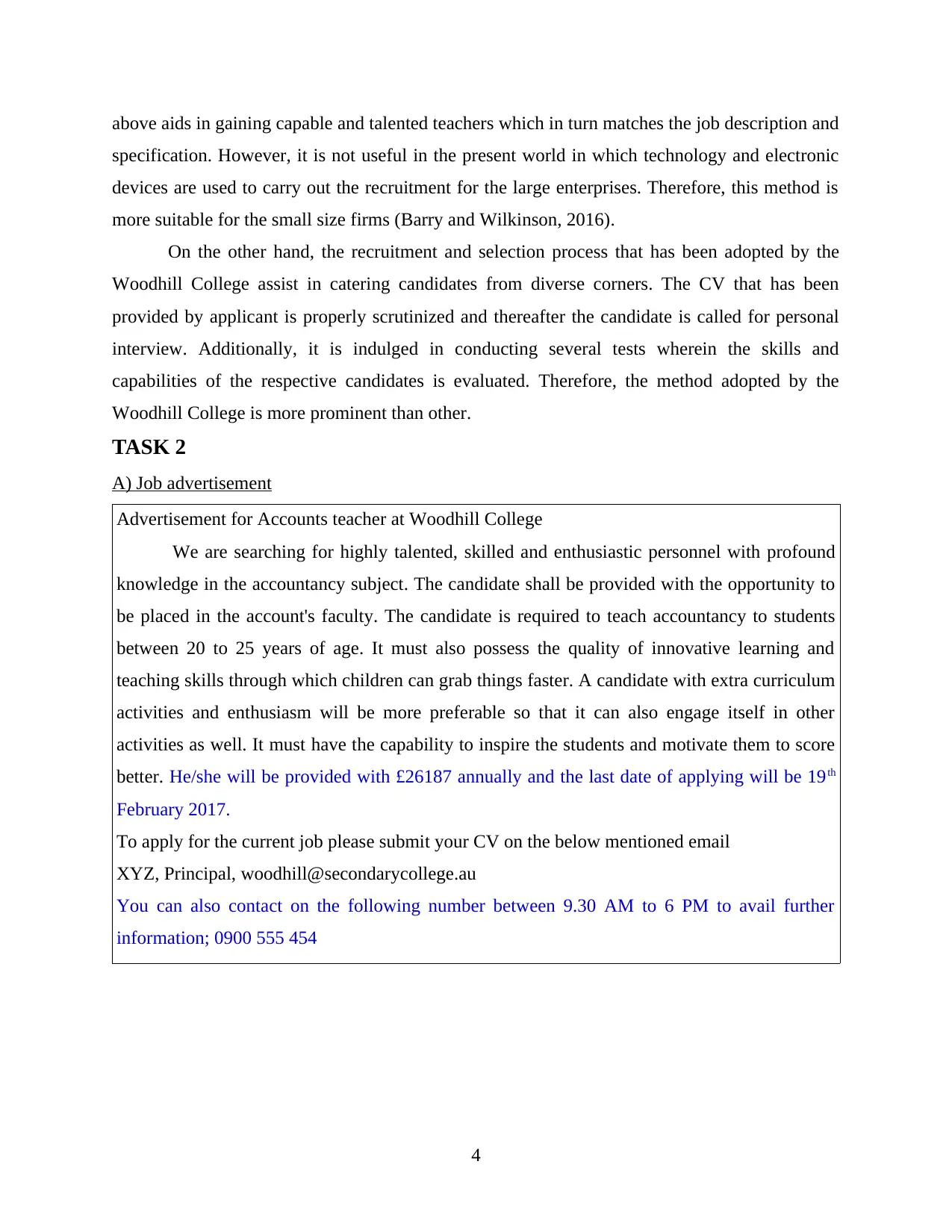
above aids in gaining capable and talented teachers which in turn matches the job description and
specification. However, it is not useful in the present world in which technology and electronic
devices are used to carry out the recruitment for the large enterprises. Therefore, this method is
more suitable for the small size firms (Barry and Wilkinson, 2016).
On the other hand, the recruitment and selection process that has been adopted by the
Woodhill College assist in catering candidates from diverse corners. The CV that has been
provided by applicant is properly scrutinized and thereafter the candidate is called for personal
interview. Additionally, it is indulged in conducting several tests wherein the skills and
capabilities of the respective candidates is evaluated. Therefore, the method adopted by the
Woodhill College is more prominent than other.
TASK 2
A) Job advertisement
Advertisement for Accounts teacher at Woodhill College
We are searching for highly talented, skilled and enthusiastic personnel with profound
knowledge in the accountancy subject. The candidate shall be provided with the opportunity to
be placed in the account's faculty. The candidate is required to teach accountancy to students
between 20 to 25 years of age. It must also possess the quality of innovative learning and
teaching skills through which children can grab things faster. A candidate with extra curriculum
activities and enthusiasm will be more preferable so that it can also engage itself in other
activities as well. It must have the capability to inspire the students and motivate them to score
better. He/she will be provided with £26187 annually and the last date of applying will be 19th
February 2017.
To apply for the current job please submit your CV on the below mentioned email
XYZ, Principal, woodhill@secondarycollege.au
You can also contact on the following number between 9.30 AM to 6 PM to avail further
information; 0900 555 454
4
specification. However, it is not useful in the present world in which technology and electronic
devices are used to carry out the recruitment for the large enterprises. Therefore, this method is
more suitable for the small size firms (Barry and Wilkinson, 2016).
On the other hand, the recruitment and selection process that has been adopted by the
Woodhill College assist in catering candidates from diverse corners. The CV that has been
provided by applicant is properly scrutinized and thereafter the candidate is called for personal
interview. Additionally, it is indulged in conducting several tests wherein the skills and
capabilities of the respective candidates is evaluated. Therefore, the method adopted by the
Woodhill College is more prominent than other.
TASK 2
A) Job advertisement
Advertisement for Accounts teacher at Woodhill College
We are searching for highly talented, skilled and enthusiastic personnel with profound
knowledge in the accountancy subject. The candidate shall be provided with the opportunity to
be placed in the account's faculty. The candidate is required to teach accountancy to students
between 20 to 25 years of age. It must also possess the quality of innovative learning and
teaching skills through which children can grab things faster. A candidate with extra curriculum
activities and enthusiasm will be more preferable so that it can also engage itself in other
activities as well. It must have the capability to inspire the students and motivate them to score
better. He/she will be provided with £26187 annually and the last date of applying will be 19th
February 2017.
To apply for the current job please submit your CV on the below mentioned email
XYZ, Principal, woodhill@secondarycollege.au
You can also contact on the following number between 9.30 AM to 6 PM to avail further
information; 0900 555 454
4
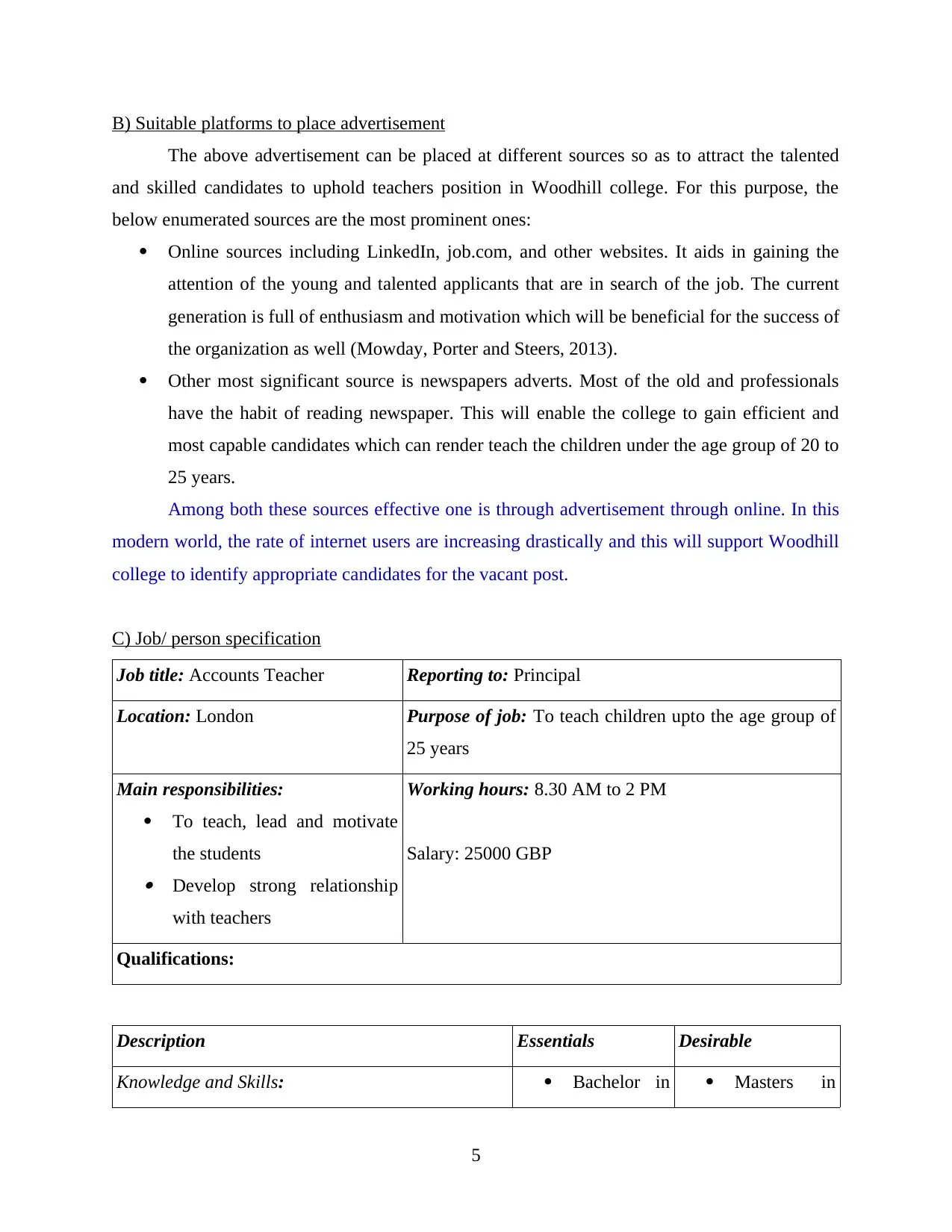
B) Suitable platforms to place advertisement
The above advertisement can be placed at different sources so as to attract the talented
and skilled candidates to uphold teachers position in Woodhill college. For this purpose, the
below enumerated sources are the most prominent ones:
Online sources including LinkedIn, job.com, and other websites. It aids in gaining the
attention of the young and talented applicants that are in search of the job. The current
generation is full of enthusiasm and motivation which will be beneficial for the success of
the organization as well (Mowday, Porter and Steers, 2013).
Other most significant source is newspapers adverts. Most of the old and professionals
have the habit of reading newspaper. This will enable the college to gain efficient and
most capable candidates which can render teach the children under the age group of 20 to
25 years.
Among both these sources effective one is through advertisement through online. In this
modern world, the rate of internet users are increasing drastically and this will support Woodhill
college to identify appropriate candidates for the vacant post.
C) Job/ person specification
Job title: Accounts Teacher Reporting to: Principal
Location: London Purpose of job: To teach children upto the age group of
25 years
Main responsibilities:
To teach, lead and motivate
the students Develop strong relationship
with teachers
Working hours: 8.30 AM to 2 PM
Salary: 25000 GBP
Qualifications:
Description Essentials Desirable
Knowledge and Skills: Bachelor in Masters in
5
The above advertisement can be placed at different sources so as to attract the talented
and skilled candidates to uphold teachers position in Woodhill college. For this purpose, the
below enumerated sources are the most prominent ones:
Online sources including LinkedIn, job.com, and other websites. It aids in gaining the
attention of the young and talented applicants that are in search of the job. The current
generation is full of enthusiasm and motivation which will be beneficial for the success of
the organization as well (Mowday, Porter and Steers, 2013).
Other most significant source is newspapers adverts. Most of the old and professionals
have the habit of reading newspaper. This will enable the college to gain efficient and
most capable candidates which can render teach the children under the age group of 20 to
25 years.
Among both these sources effective one is through advertisement through online. In this
modern world, the rate of internet users are increasing drastically and this will support Woodhill
college to identify appropriate candidates for the vacant post.
C) Job/ person specification
Job title: Accounts Teacher Reporting to: Principal
Location: London Purpose of job: To teach children upto the age group of
25 years
Main responsibilities:
To teach, lead and motivate
the students Develop strong relationship
with teachers
Working hours: 8.30 AM to 2 PM
Salary: 25000 GBP
Qualifications:
Description Essentials Desirable
Knowledge and Skills: Bachelor in Masters in
5
Paraphrase This Document
Need a fresh take? Get an instant paraphrase of this document with our AI Paraphraser
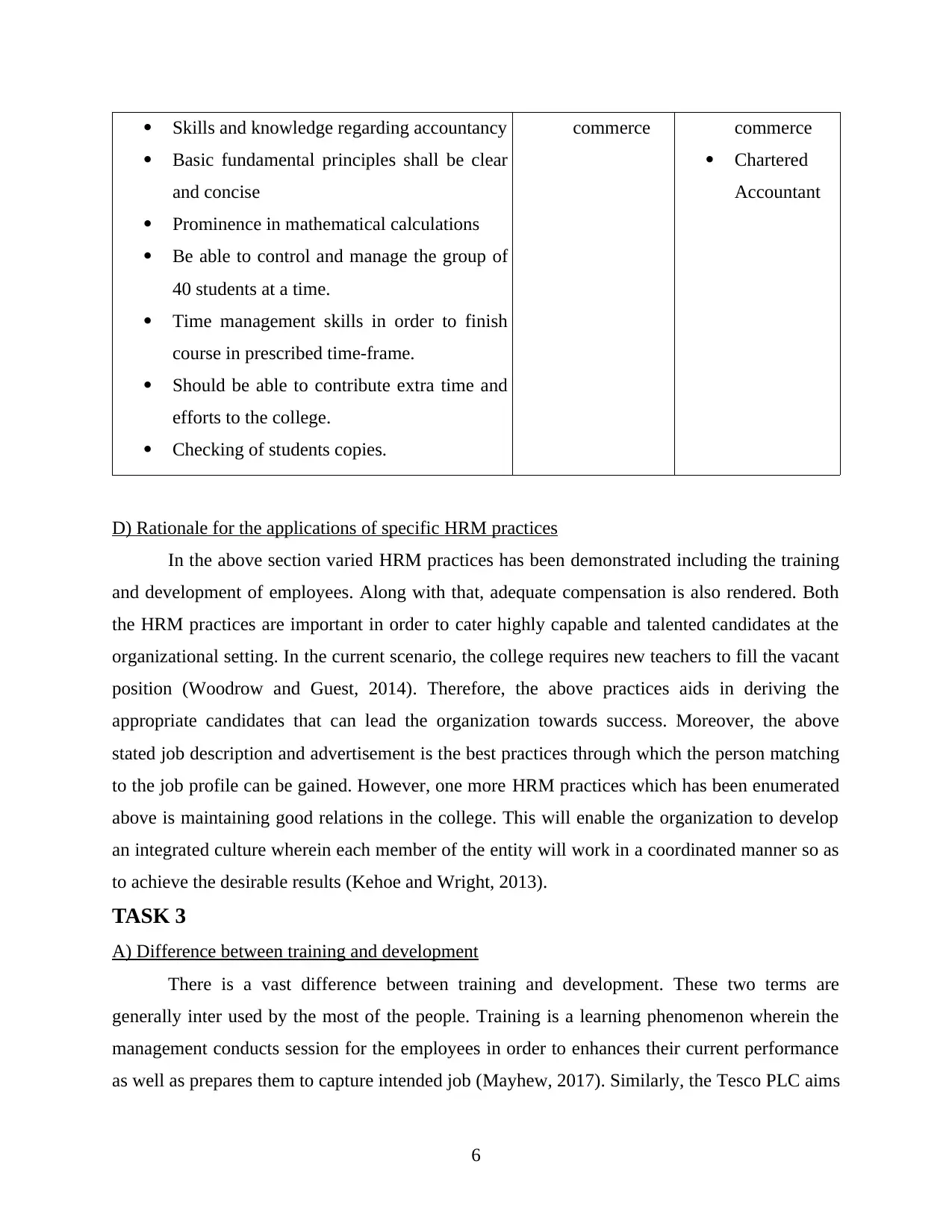
Skills and knowledge regarding accountancy
Basic fundamental principles shall be clear
and concise
Prominence in mathematical calculations
Be able to control and manage the group of
40 students at a time.
Time management skills in order to finish
course in prescribed time-frame.
Should be able to contribute extra time and
efforts to the college.
Checking of students copies.
commerce commerce
Chartered
Accountant
D) Rationale for the applications of specific HRM practices
In the above section varied HRM practices has been demonstrated including the training
and development of employees. Along with that, adequate compensation is also rendered. Both
the HRM practices are important in order to cater highly capable and talented candidates at the
organizational setting. In the current scenario, the college requires new teachers to fill the vacant
position (Woodrow and Guest, 2014). Therefore, the above practices aids in deriving the
appropriate candidates that can lead the organization towards success. Moreover, the above
stated job description and advertisement is the best practices through which the person matching
to the job profile can be gained. However, one more HRM practices which has been enumerated
above is maintaining good relations in the college. This will enable the organization to develop
an integrated culture wherein each member of the entity will work in a coordinated manner so as
to achieve the desirable results (Kehoe and Wright, 2013).
TASK 3
A) Difference between training and development
There is a vast difference between training and development. These two terms are
generally inter used by the most of the people. Training is a learning phenomenon wherein the
management conducts session for the employees in order to enhances their current performance
as well as prepares them to capture intended job (Mayhew, 2017). Similarly, the Tesco PLC aims
6
Basic fundamental principles shall be clear
and concise
Prominence in mathematical calculations
Be able to control and manage the group of
40 students at a time.
Time management skills in order to finish
course in prescribed time-frame.
Should be able to contribute extra time and
efforts to the college.
Checking of students copies.
commerce commerce
Chartered
Accountant
D) Rationale for the applications of specific HRM practices
In the above section varied HRM practices has been demonstrated including the training
and development of employees. Along with that, adequate compensation is also rendered. Both
the HRM practices are important in order to cater highly capable and talented candidates at the
organizational setting. In the current scenario, the college requires new teachers to fill the vacant
position (Woodrow and Guest, 2014). Therefore, the above practices aids in deriving the
appropriate candidates that can lead the organization towards success. Moreover, the above
stated job description and advertisement is the best practices through which the person matching
to the job profile can be gained. However, one more HRM practices which has been enumerated
above is maintaining good relations in the college. This will enable the organization to develop
an integrated culture wherein each member of the entity will work in a coordinated manner so as
to achieve the desirable results (Kehoe and Wright, 2013).
TASK 3
A) Difference between training and development
There is a vast difference between training and development. These two terms are
generally inter used by the most of the people. Training is a learning phenomenon wherein the
management conducts session for the employees in order to enhances their current performance
as well as prepares them to capture intended job (Mayhew, 2017). Similarly, the Tesco PLC aims
6

to provide training and development programmes for the better growth and prospectus of the
organization. In contrast to this, development programmes are conducted by the management in
order to develop the personality and traits of the individual. Along with that, it assures career
development opportunities to the people. Some of the major differences between the two has
been enlisted underneath:
Training Development
Training is offered to the candidates to gain
knowledge on specific areas related to the job
Development sessions is basically to disperse
general knowledge
It is short term activity It is an educational process and long term in
nature
Employees at Tesco PLC are provided with
necessary instructions on mechanical and
technical problems.
Generally educational and theoretical
knowledge is rendered in the development
programmes (Richason, 2017).
B) Effects of changing customer preferences
With the advancement in technology, customers needs and expectations are changing
over time. Tesco is the leading company of UK which deals in wide range of grocery products.
The customer expects these products should be in appropriate quality and quantity (Ingram,
2017). Therefore, to meet the above requirements of the consumers, the company aims to train its
staff members in laying more consideration towards appropriate packaging and selling of goods.
Additionally, it has also provided training to its staff members of production department in order
to maintain the quality in manufacturing goods.
Apart from this, it has also been assessed that customers are more considerable about the
manner in which the employees greet and treat them at retail outlets. Therefore, Tesco PLC feels
the need to train its employees regarding the methods or ways in which grievances and
complaints of the employees should be addressed. On the job training is designed in the similar
manner so as to allow the staff members to deal with the customers and other members in the
appropriate manner (Guedes, 2015). Likewise, there are several departments in the concerned
organization and based on the customer expectations training is rendered to the employees.
7
organization. In contrast to this, development programmes are conducted by the management in
order to develop the personality and traits of the individual. Along with that, it assures career
development opportunities to the people. Some of the major differences between the two has
been enlisted underneath:
Training Development
Training is offered to the candidates to gain
knowledge on specific areas related to the job
Development sessions is basically to disperse
general knowledge
It is short term activity It is an educational process and long term in
nature
Employees at Tesco PLC are provided with
necessary instructions on mechanical and
technical problems.
Generally educational and theoretical
knowledge is rendered in the development
programmes (Richason, 2017).
B) Effects of changing customer preferences
With the advancement in technology, customers needs and expectations are changing
over time. Tesco is the leading company of UK which deals in wide range of grocery products.
The customer expects these products should be in appropriate quality and quantity (Ingram,
2017). Therefore, to meet the above requirements of the consumers, the company aims to train its
staff members in laying more consideration towards appropriate packaging and selling of goods.
Additionally, it has also provided training to its staff members of production department in order
to maintain the quality in manufacturing goods.
Apart from this, it has also been assessed that customers are more considerable about the
manner in which the employees greet and treat them at retail outlets. Therefore, Tesco PLC feels
the need to train its employees regarding the methods or ways in which grievances and
complaints of the employees should be addressed. On the job training is designed in the similar
manner so as to allow the staff members to deal with the customers and other members in the
appropriate manner (Guedes, 2015). Likewise, there are several departments in the concerned
organization and based on the customer expectations training is rendered to the employees.
7
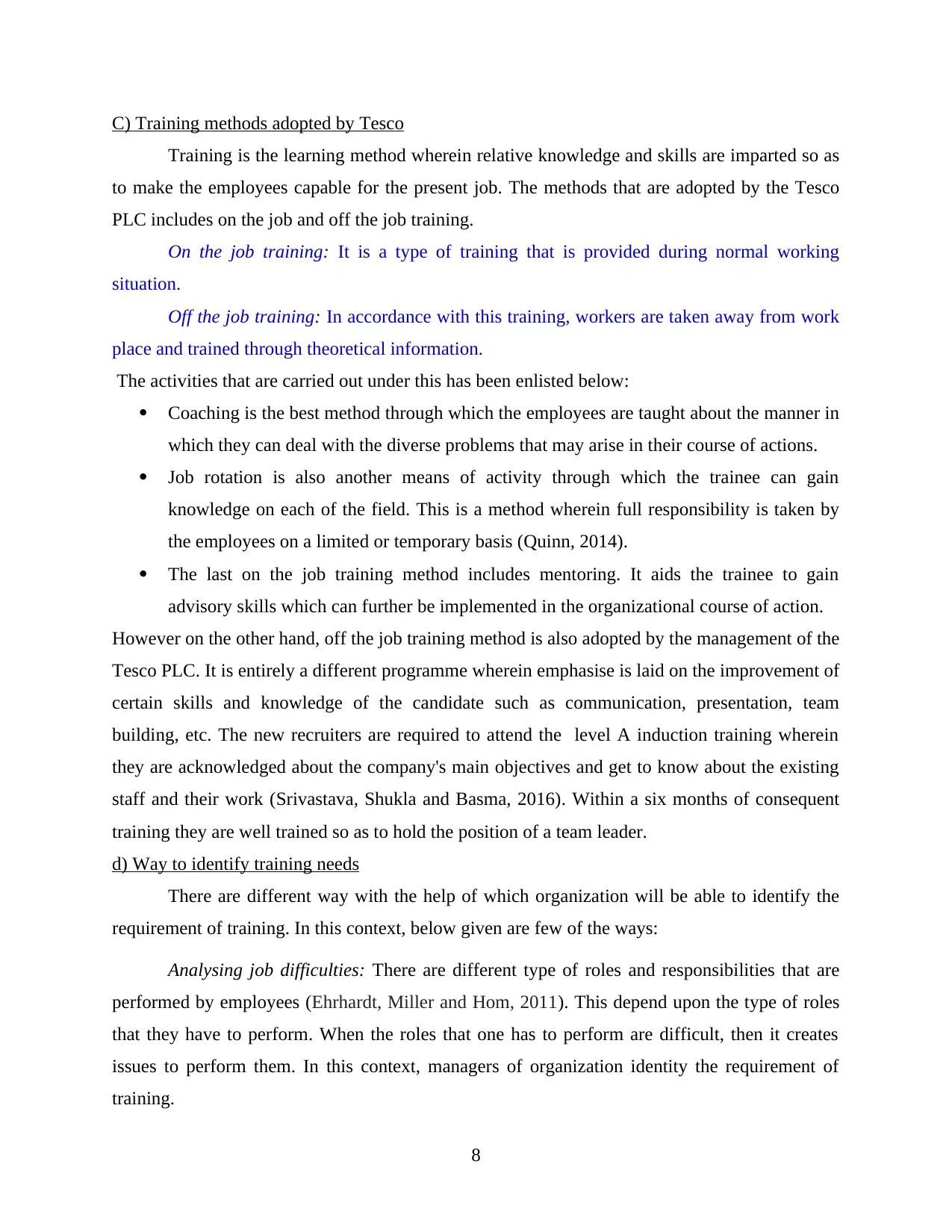
C) Training methods adopted by Tesco
Training is the learning method wherein relative knowledge and skills are imparted so as
to make the employees capable for the present job. The methods that are adopted by the Tesco
PLC includes on the job and off the job training.
On the job training: It is a type of training that is provided during normal working
situation.
Off the job training: In accordance with this training, workers are taken away from work
place and trained through theoretical information.
The activities that are carried out under this has been enlisted below:
Coaching is the best method through which the employees are taught about the manner in
which they can deal with the diverse problems that may arise in their course of actions.
Job rotation is also another means of activity through which the trainee can gain
knowledge on each of the field. This is a method wherein full responsibility is taken by
the employees on a limited or temporary basis (Quinn, 2014).
The last on the job training method includes mentoring. It aids the trainee to gain
advisory skills which can further be implemented in the organizational course of action.
However on the other hand, off the job training method is also adopted by the management of the
Tesco PLC. It is entirely a different programme wherein emphasise is laid on the improvement of
certain skills and knowledge of the candidate such as communication, presentation, team
building, etc. The new recruiters are required to attend the level A induction training wherein
they are acknowledged about the company's main objectives and get to know about the existing
staff and their work (Srivastava, Shukla and Basma, 2016). Within a six months of consequent
training they are well trained so as to hold the position of a team leader.
d) Way to identify training needs
There are different way with the help of which organization will be able to identify the
requirement of training. In this context, below given are few of the ways:
Analysing job difficulties: There are different type of roles and responsibilities that are
performed by employees (Ehrhardt, Miller and Hom, 2011). This depend upon the type of roles
that they have to perform. When the roles that one has to perform are difficult, then it creates
issues to perform them. In this context, managers of organization identity the requirement of
training.
8
Training is the learning method wherein relative knowledge and skills are imparted so as
to make the employees capable for the present job. The methods that are adopted by the Tesco
PLC includes on the job and off the job training.
On the job training: It is a type of training that is provided during normal working
situation.
Off the job training: In accordance with this training, workers are taken away from work
place and trained through theoretical information.
The activities that are carried out under this has been enlisted below:
Coaching is the best method through which the employees are taught about the manner in
which they can deal with the diverse problems that may arise in their course of actions.
Job rotation is also another means of activity through which the trainee can gain
knowledge on each of the field. This is a method wherein full responsibility is taken by
the employees on a limited or temporary basis (Quinn, 2014).
The last on the job training method includes mentoring. It aids the trainee to gain
advisory skills which can further be implemented in the organizational course of action.
However on the other hand, off the job training method is also adopted by the management of the
Tesco PLC. It is entirely a different programme wherein emphasise is laid on the improvement of
certain skills and knowledge of the candidate such as communication, presentation, team
building, etc. The new recruiters are required to attend the level A induction training wherein
they are acknowledged about the company's main objectives and get to know about the existing
staff and their work (Srivastava, Shukla and Basma, 2016). Within a six months of consequent
training they are well trained so as to hold the position of a team leader.
d) Way to identify training needs
There are different way with the help of which organization will be able to identify the
requirement of training. In this context, below given are few of the ways:
Analysing job difficulties: There are different type of roles and responsibilities that are
performed by employees (Ehrhardt, Miller and Hom, 2011). This depend upon the type of roles
that they have to perform. When the roles that one has to perform are difficult, then it creates
issues to perform them. In this context, managers of organization identity the requirement of
training.
8
Secure Best Marks with AI Grader
Need help grading? Try our AI Grader for instant feedback on your assignments.
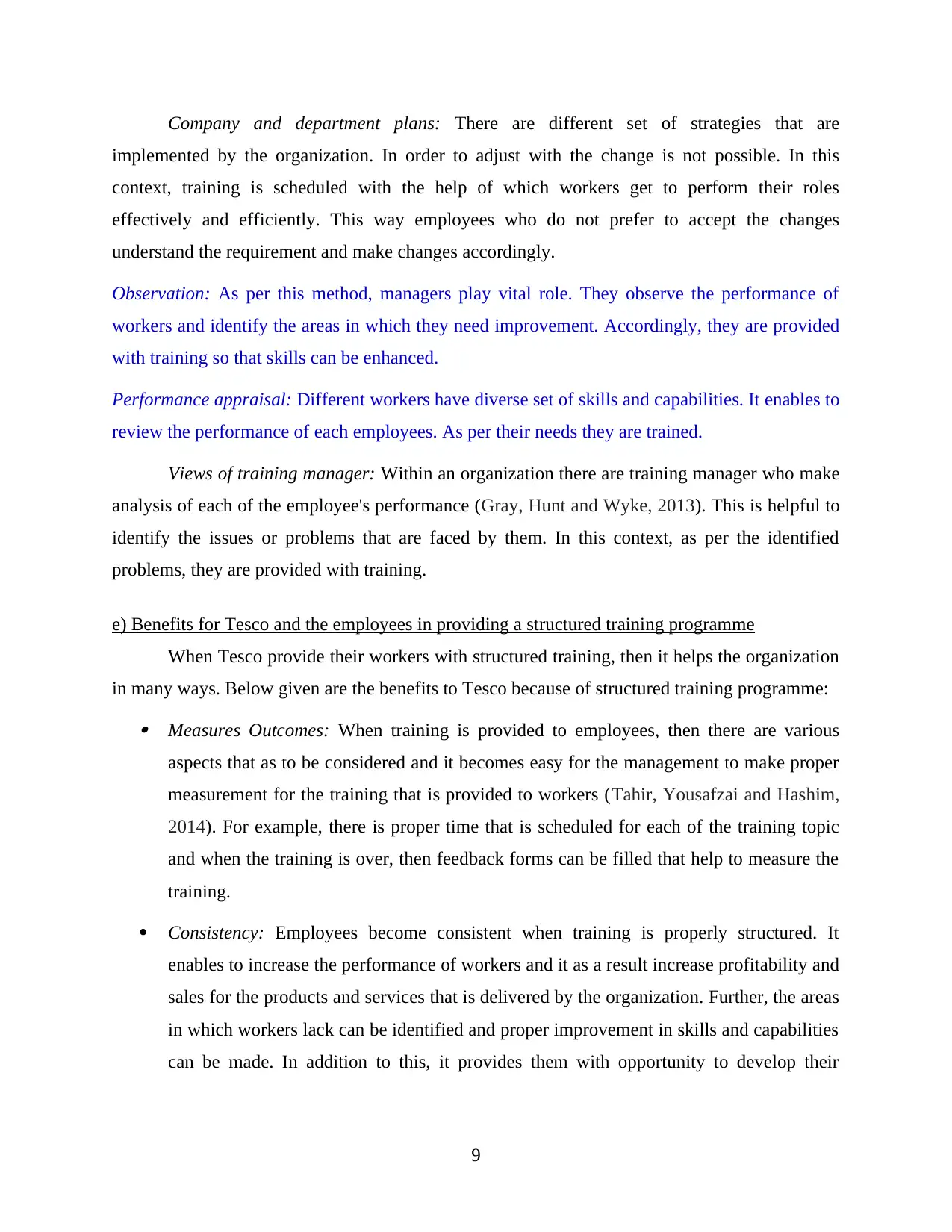
Company and department plans: There are different set of strategies that are
implemented by the organization. In order to adjust with the change is not possible. In this
context, training is scheduled with the help of which workers get to perform their roles
effectively and efficiently. This way employees who do not prefer to accept the changes
understand the requirement and make changes accordingly.
Observation: As per this method, managers play vital role. They observe the performance of
workers and identify the areas in which they need improvement. Accordingly, they are provided
with training so that skills can be enhanced.
Performance appraisal: Different workers have diverse set of skills and capabilities. It enables to
review the performance of each employees. As per their needs they are trained.
Views of training manager: Within an organization there are training manager who make
analysis of each of the employee's performance (Gray, Hunt and Wyke, 2013). This is helpful to
identify the issues or problems that are faced by them. In this context, as per the identified
problems, they are provided with training.
e) Benefits for Tesco and the employees in providing a structured training programme
When Tesco provide their workers with structured training, then it helps the organization
in many ways. Below given are the benefits to Tesco because of structured training programme: Measures Outcomes: When training is provided to employees, then there are various
aspects that as to be considered and it becomes easy for the management to make proper
measurement for the training that is provided to workers (Tahir, Yousafzai and Hashim,
2014). For example, there is proper time that is scheduled for each of the training topic
and when the training is over, then feedback forms can be filled that help to measure the
training.
Consistency: Employees become consistent when training is properly structured. It
enables to increase the performance of workers and it as a result increase profitability and
sales for the products and services that is delivered by the organization. Further, the areas
in which workers lack can be identified and proper improvement in skills and capabilities
can be made. In addition to this, it provides them with opportunity to develop their
9
implemented by the organization. In order to adjust with the change is not possible. In this
context, training is scheduled with the help of which workers get to perform their roles
effectively and efficiently. This way employees who do not prefer to accept the changes
understand the requirement and make changes accordingly.
Observation: As per this method, managers play vital role. They observe the performance of
workers and identify the areas in which they need improvement. Accordingly, they are provided
with training so that skills can be enhanced.
Performance appraisal: Different workers have diverse set of skills and capabilities. It enables to
review the performance of each employees. As per their needs they are trained.
Views of training manager: Within an organization there are training manager who make
analysis of each of the employee's performance (Gray, Hunt and Wyke, 2013). This is helpful to
identify the issues or problems that are faced by them. In this context, as per the identified
problems, they are provided with training.
e) Benefits for Tesco and the employees in providing a structured training programme
When Tesco provide their workers with structured training, then it helps the organization
in many ways. Below given are the benefits to Tesco because of structured training programme: Measures Outcomes: When training is provided to employees, then there are various
aspects that as to be considered and it becomes easy for the management to make proper
measurement for the training that is provided to workers (Tahir, Yousafzai and Hashim,
2014). For example, there is proper time that is scheduled for each of the training topic
and when the training is over, then feedback forms can be filled that help to measure the
training.
Consistency: Employees become consistent when training is properly structured. It
enables to increase the performance of workers and it as a result increase profitability and
sales for the products and services that is delivered by the organization. Further, the areas
in which workers lack can be identified and proper improvement in skills and capabilities
can be made. In addition to this, it provides them with opportunity to develop their
9
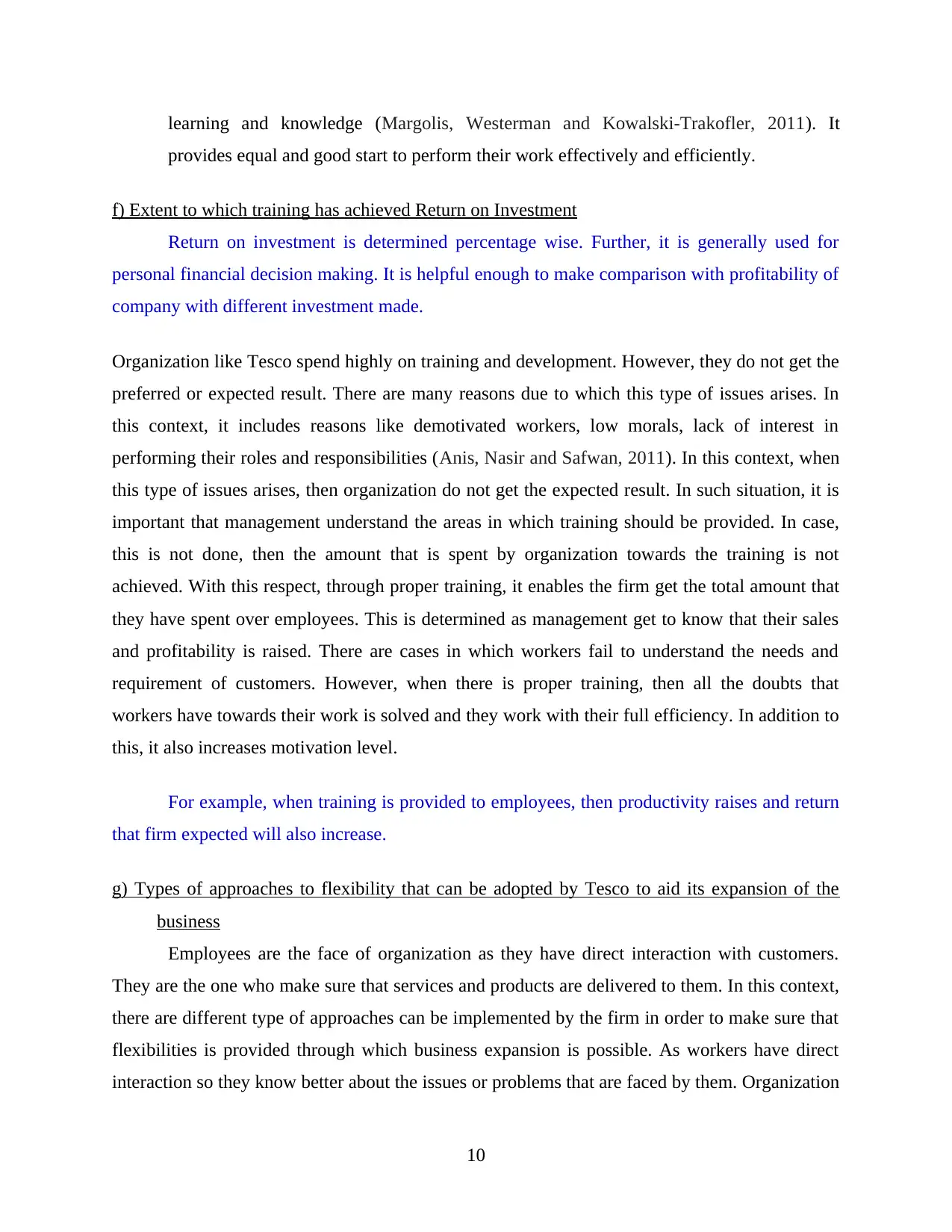
learning and knowledge (Margolis, Westerman and Kowalski-Trakofler, 2011). It
provides equal and good start to perform their work effectively and efficiently.
f) Extent to which training has achieved Return on Investment
Return on investment is determined percentage wise. Further, it is generally used for
personal financial decision making. It is helpful enough to make comparison with profitability of
company with different investment made.
Organization like Tesco spend highly on training and development. However, they do not get the
preferred or expected result. There are many reasons due to which this type of issues arises. In
this context, it includes reasons like demotivated workers, low morals, lack of interest in
performing their roles and responsibilities (Anis, Nasir and Safwan, 2011). In this context, when
this type of issues arises, then organization do not get the expected result. In such situation, it is
important that management understand the areas in which training should be provided. In case,
this is not done, then the amount that is spent by organization towards the training is not
achieved. With this respect, through proper training, it enables the firm get the total amount that
they have spent over employees. This is determined as management get to know that their sales
and profitability is raised. There are cases in which workers fail to understand the needs and
requirement of customers. However, when there is proper training, then all the doubts that
workers have towards their work is solved and they work with their full efficiency. In addition to
this, it also increases motivation level.
For example, when training is provided to employees, then productivity raises and return
that firm expected will also increase.
g) Types of approaches to flexibility that can be adopted by Tesco to aid its expansion of the
business
Employees are the face of organization as they have direct interaction with customers.
They are the one who make sure that services and products are delivered to them. In this context,
there are different type of approaches can be implemented by the firm in order to make sure that
flexibilities is provided through which business expansion is possible. As workers have direct
interaction so they know better about the issues or problems that are faced by them. Organization
10
provides equal and good start to perform their work effectively and efficiently.
f) Extent to which training has achieved Return on Investment
Return on investment is determined percentage wise. Further, it is generally used for
personal financial decision making. It is helpful enough to make comparison with profitability of
company with different investment made.
Organization like Tesco spend highly on training and development. However, they do not get the
preferred or expected result. There are many reasons due to which this type of issues arises. In
this context, it includes reasons like demotivated workers, low morals, lack of interest in
performing their roles and responsibilities (Anis, Nasir and Safwan, 2011). In this context, when
this type of issues arises, then organization do not get the expected result. In such situation, it is
important that management understand the areas in which training should be provided. In case,
this is not done, then the amount that is spent by organization towards the training is not
achieved. With this respect, through proper training, it enables the firm get the total amount that
they have spent over employees. This is determined as management get to know that their sales
and profitability is raised. There are cases in which workers fail to understand the needs and
requirement of customers. However, when there is proper training, then all the doubts that
workers have towards their work is solved and they work with their full efficiency. In addition to
this, it also increases motivation level.
For example, when training is provided to employees, then productivity raises and return
that firm expected will also increase.
g) Types of approaches to flexibility that can be adopted by Tesco to aid its expansion of the
business
Employees are the face of organization as they have direct interaction with customers.
They are the one who make sure that services and products are delivered to them. In this context,
there are different type of approaches can be implemented by the firm in order to make sure that
flexibilities is provided through which business expansion is possible. As workers have direct
interaction so they know better about the issues or problems that are faced by them. Organization
10
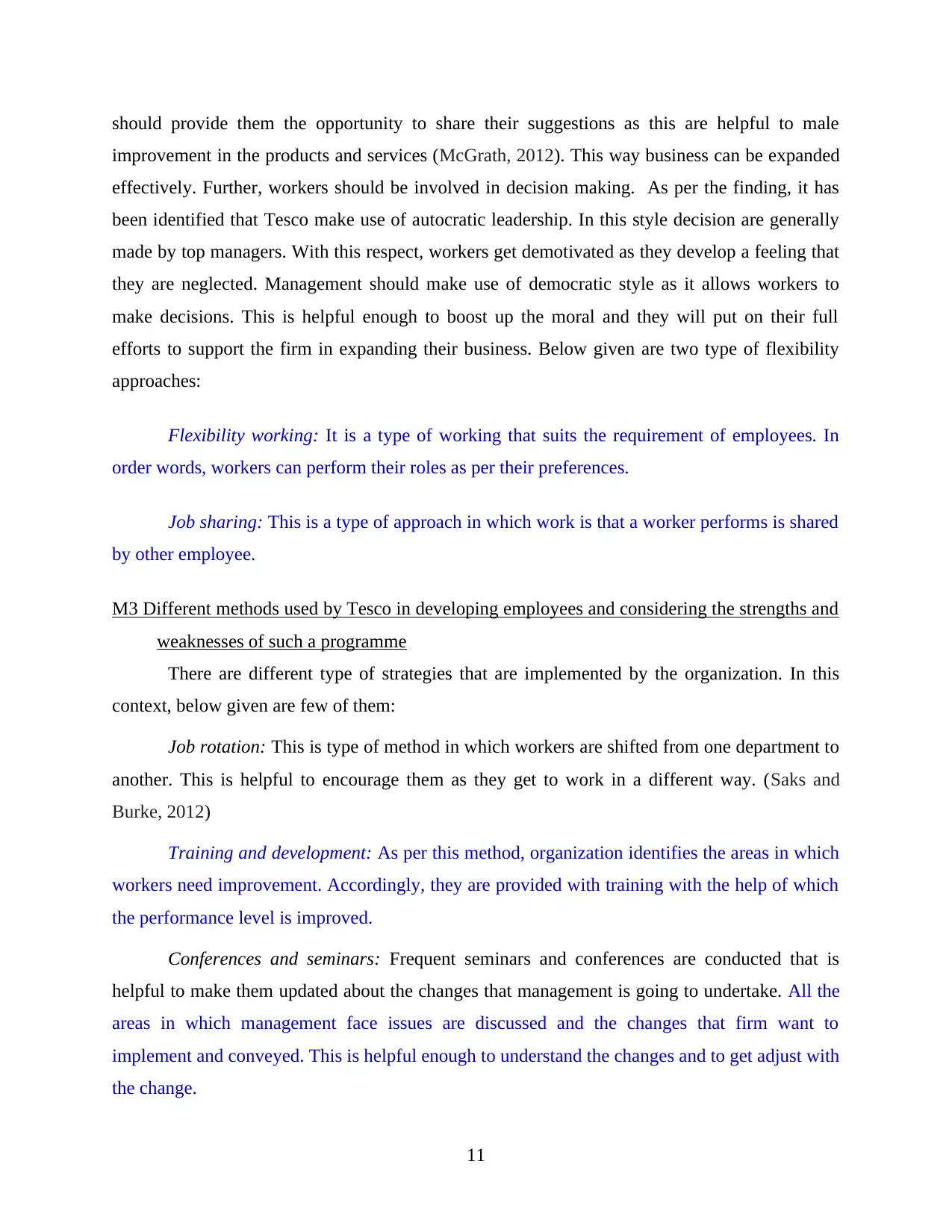
should provide them the opportunity to share their suggestions as this are helpful to male
improvement in the products and services (McGrath, 2012). This way business can be expanded
effectively. Further, workers should be involved in decision making. As per the finding, it has
been identified that Tesco make use of autocratic leadership. In this style decision are generally
made by top managers. With this respect, workers get demotivated as they develop a feeling that
they are neglected. Management should make use of democratic style as it allows workers to
make decisions. This is helpful enough to boost up the moral and they will put on their full
efforts to support the firm in expanding their business. Below given are two type of flexibility
approaches:
Flexibility working: It is a type of working that suits the requirement of employees. In
order words, workers can perform their roles as per their preferences.
Job sharing: This is a type of approach in which work is that a worker performs is shared
by other employee.
M3 Different methods used by Tesco in developing employees and considering the strengths and
weaknesses of such a programme
There are different type of strategies that are implemented by the organization. In this
context, below given are few of them:
Job rotation: This is type of method in which workers are shifted from one department to
another. This is helpful to encourage them as they get to work in a different way. (Saks and
Burke, 2012)
Training and development: As per this method, organization identifies the areas in which
workers need improvement. Accordingly, they are provided with training with the help of which
the performance level is improved.
Conferences and seminars: Frequent seminars and conferences are conducted that is
helpful to make them updated about the changes that management is going to undertake. All the
areas in which management face issues are discussed and the changes that firm want to
implement and conveyed. This is helpful enough to understand the changes and to get adjust with
the change.
11
improvement in the products and services (McGrath, 2012). This way business can be expanded
effectively. Further, workers should be involved in decision making. As per the finding, it has
been identified that Tesco make use of autocratic leadership. In this style decision are generally
made by top managers. With this respect, workers get demotivated as they develop a feeling that
they are neglected. Management should make use of democratic style as it allows workers to
make decisions. This is helpful enough to boost up the moral and they will put on their full
efforts to support the firm in expanding their business. Below given are two type of flexibility
approaches:
Flexibility working: It is a type of working that suits the requirement of employees. In
order words, workers can perform their roles as per their preferences.
Job sharing: This is a type of approach in which work is that a worker performs is shared
by other employee.
M3 Different methods used by Tesco in developing employees and considering the strengths and
weaknesses of such a programme
There are different type of strategies that are implemented by the organization. In this
context, below given are few of them:
Job rotation: This is type of method in which workers are shifted from one department to
another. This is helpful to encourage them as they get to work in a different way. (Saks and
Burke, 2012)
Training and development: As per this method, organization identifies the areas in which
workers need improvement. Accordingly, they are provided with training with the help of which
the performance level is improved.
Conferences and seminars: Frequent seminars and conferences are conducted that is
helpful to make them updated about the changes that management is going to undertake. All the
areas in which management face issues are discussed and the changes that firm want to
implement and conveyed. This is helpful enough to understand the changes and to get adjust with
the change.
11
Paraphrase This Document
Need a fresh take? Get an instant paraphrase of this document with our AI Paraphraser
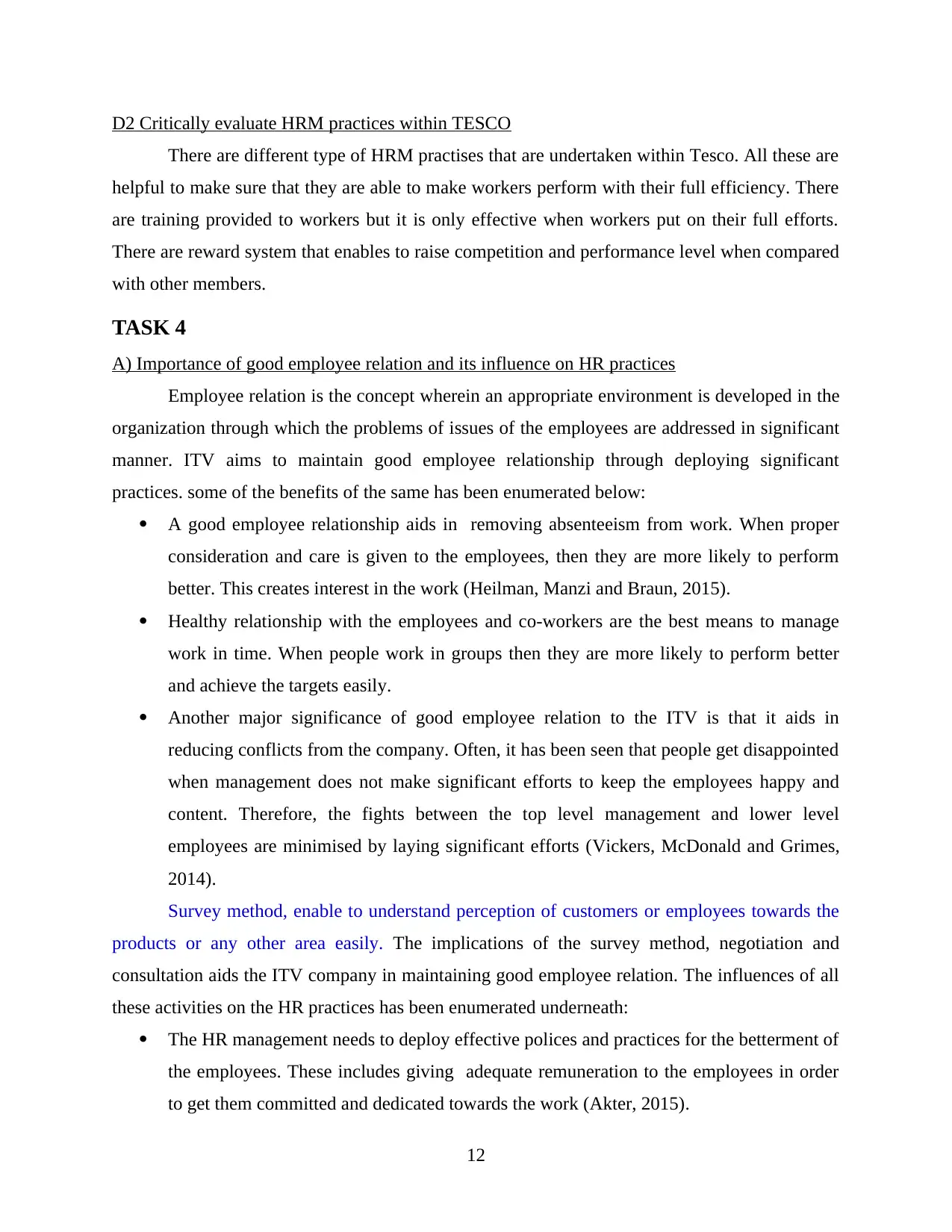
D2 Critically evaluate HRM practices within TESCO
There are different type of HRM practises that are undertaken within Tesco. All these are
helpful to make sure that they are able to make workers perform with their full efficiency. There
are training provided to workers but it is only effective when workers put on their full efforts.
There are reward system that enables to raise competition and performance level when compared
with other members.
TASK 4
A) Importance of good employee relation and its influence on HR practices
Employee relation is the concept wherein an appropriate environment is developed in the
organization through which the problems of issues of the employees are addressed in significant
manner. ITV aims to maintain good employee relationship through deploying significant
practices. some of the benefits of the same has been enumerated below:
A good employee relationship aids in removing absenteeism from work. When proper
consideration and care is given to the employees, then they are more likely to perform
better. This creates interest in the work (Heilman, Manzi and Braun, 2015).
Healthy relationship with the employees and co-workers are the best means to manage
work in time. When people work in groups then they are more likely to perform better
and achieve the targets easily.
Another major significance of good employee relation to the ITV is that it aids in
reducing conflicts from the company. Often, it has been seen that people get disappointed
when management does not make significant efforts to keep the employees happy and
content. Therefore, the fights between the top level management and lower level
employees are minimised by laying significant efforts (Vickers, McDonald and Grimes,
2014).
Survey method, enable to understand perception of customers or employees towards the
products or any other area easily. The implications of the survey method, negotiation and
consultation aids the ITV company in maintaining good employee relation. The influences of all
these activities on the HR practices has been enumerated underneath:
The HR management needs to deploy effective polices and practices for the betterment of
the employees. These includes giving adequate remuneration to the employees in order
to get them committed and dedicated towards the work (Akter, 2015).
12
There are different type of HRM practises that are undertaken within Tesco. All these are
helpful to make sure that they are able to make workers perform with their full efficiency. There
are training provided to workers but it is only effective when workers put on their full efforts.
There are reward system that enables to raise competition and performance level when compared
with other members.
TASK 4
A) Importance of good employee relation and its influence on HR practices
Employee relation is the concept wherein an appropriate environment is developed in the
organization through which the problems of issues of the employees are addressed in significant
manner. ITV aims to maintain good employee relationship through deploying significant
practices. some of the benefits of the same has been enumerated below:
A good employee relationship aids in removing absenteeism from work. When proper
consideration and care is given to the employees, then they are more likely to perform
better. This creates interest in the work (Heilman, Manzi and Braun, 2015).
Healthy relationship with the employees and co-workers are the best means to manage
work in time. When people work in groups then they are more likely to perform better
and achieve the targets easily.
Another major significance of good employee relation to the ITV is that it aids in
reducing conflicts from the company. Often, it has been seen that people get disappointed
when management does not make significant efforts to keep the employees happy and
content. Therefore, the fights between the top level management and lower level
employees are minimised by laying significant efforts (Vickers, McDonald and Grimes,
2014).
Survey method, enable to understand perception of customers or employees towards the
products or any other area easily. The implications of the survey method, negotiation and
consultation aids the ITV company in maintaining good employee relation. The influences of all
these activities on the HR practices has been enumerated underneath:
The HR management needs to deploy effective polices and practices for the betterment of
the employees. These includes giving adequate remuneration to the employees in order
to get them committed and dedicated towards the work (Akter, 2015).
12
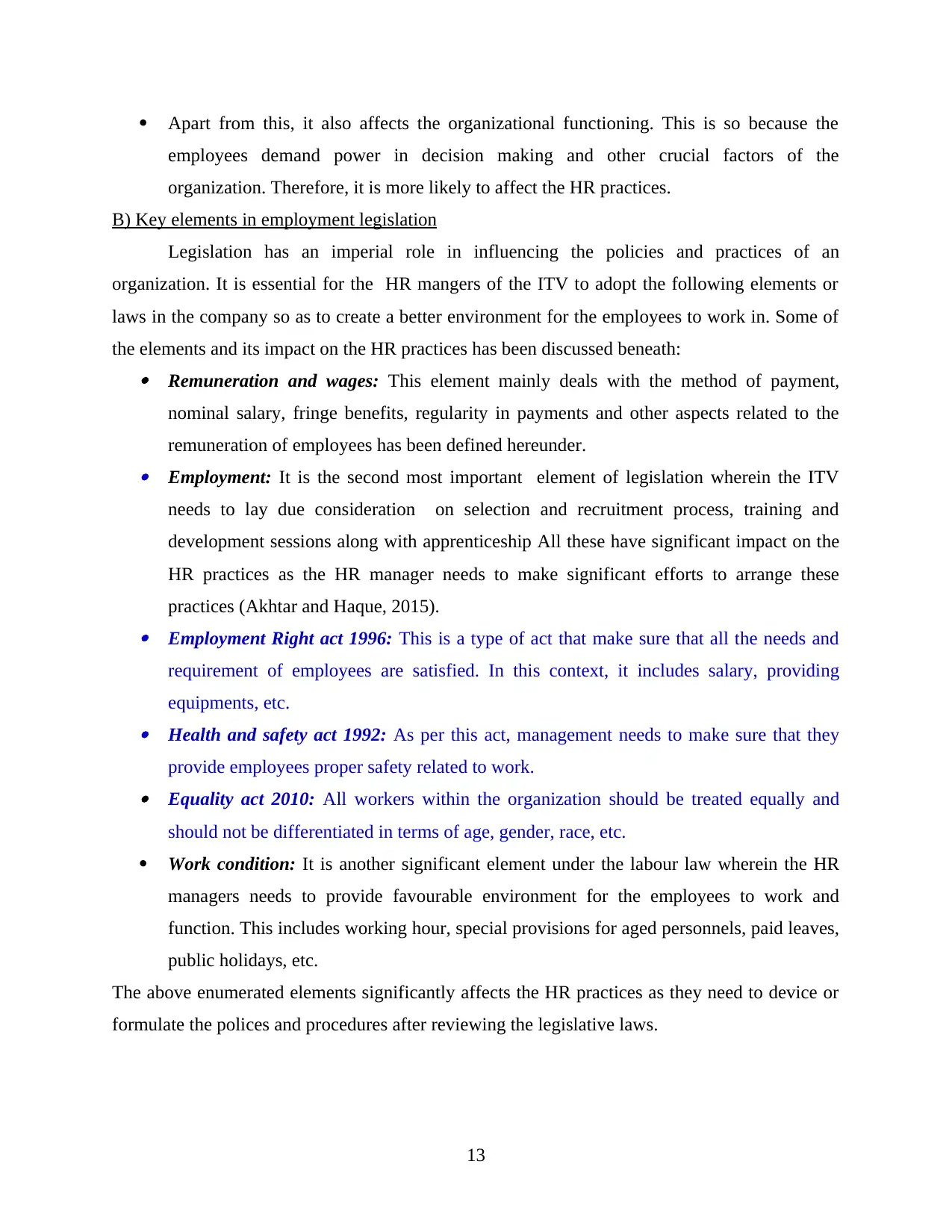
Apart from this, it also affects the organizational functioning. This is so because the
employees demand power in decision making and other crucial factors of the
organization. Therefore, it is more likely to affect the HR practices.
B) Key elements in employment legislation
Legislation has an imperial role in influencing the policies and practices of an
organization. It is essential for the HR mangers of the ITV to adopt the following elements or
laws in the company so as to create a better environment for the employees to work in. Some of
the elements and its impact on the HR practices has been discussed beneath: Remuneration and wages: This element mainly deals with the method of payment,
nominal salary, fringe benefits, regularity in payments and other aspects related to the
remuneration of employees has been defined hereunder. Employment: It is the second most important element of legislation wherein the ITV
needs to lay due consideration on selection and recruitment process, training and
development sessions along with apprenticeship All these have significant impact on the
HR practices as the HR manager needs to make significant efforts to arrange these
practices (Akhtar and Haque, 2015). Employment Right act 1996: This is a type of act that make sure that all the needs and
requirement of employees are satisfied. In this context, it includes salary, providing
equipments, etc. Health and safety act 1992: As per this act, management needs to make sure that they
provide employees proper safety related to work. Equality act 2010: All workers within the organization should be treated equally and
should not be differentiated in terms of age, gender, race, etc.
Work condition: It is another significant element under the labour law wherein the HR
managers needs to provide favourable environment for the employees to work and
function. This includes working hour, special provisions for aged personnels, paid leaves,
public holidays, etc.
The above enumerated elements significantly affects the HR practices as they need to device or
formulate the polices and procedures after reviewing the legislative laws.
13
employees demand power in decision making and other crucial factors of the
organization. Therefore, it is more likely to affect the HR practices.
B) Key elements in employment legislation
Legislation has an imperial role in influencing the policies and practices of an
organization. It is essential for the HR mangers of the ITV to adopt the following elements or
laws in the company so as to create a better environment for the employees to work in. Some of
the elements and its impact on the HR practices has been discussed beneath: Remuneration and wages: This element mainly deals with the method of payment,
nominal salary, fringe benefits, regularity in payments and other aspects related to the
remuneration of employees has been defined hereunder. Employment: It is the second most important element of legislation wherein the ITV
needs to lay due consideration on selection and recruitment process, training and
development sessions along with apprenticeship All these have significant impact on the
HR practices as the HR manager needs to make significant efforts to arrange these
practices (Akhtar and Haque, 2015). Employment Right act 1996: This is a type of act that make sure that all the needs and
requirement of employees are satisfied. In this context, it includes salary, providing
equipments, etc. Health and safety act 1992: As per this act, management needs to make sure that they
provide employees proper safety related to work. Equality act 2010: All workers within the organization should be treated equally and
should not be differentiated in terms of age, gender, race, etc.
Work condition: It is another significant element under the labour law wherein the HR
managers needs to provide favourable environment for the employees to work and
function. This includes working hour, special provisions for aged personnels, paid leaves,
public holidays, etc.
The above enumerated elements significantly affects the HR practices as they need to device or
formulate the polices and procedures after reviewing the legislative laws.
13
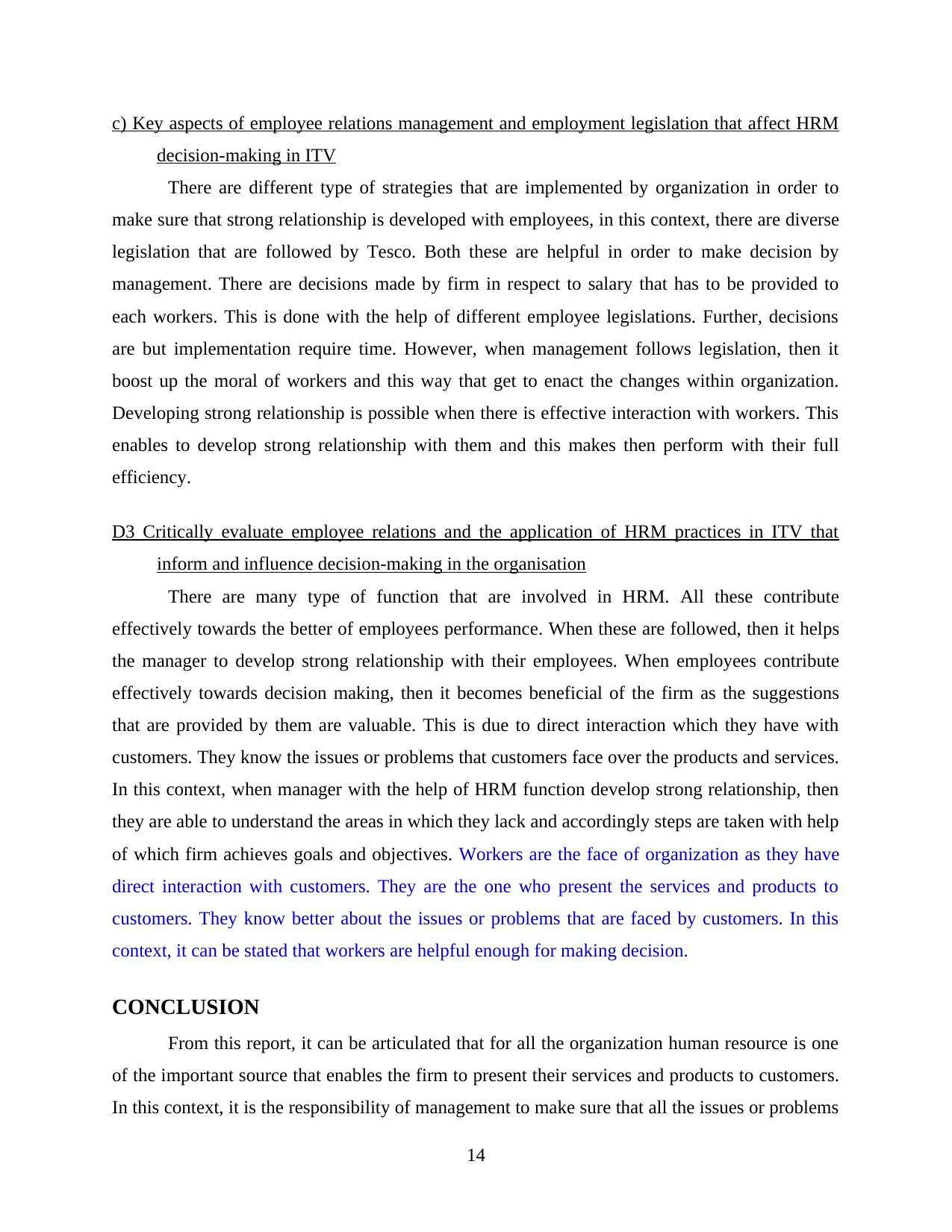
c) Key aspects of employee relations management and employment legislation that affect HRM
decision-making in ITV
There are different type of strategies that are implemented by organization in order to
make sure that strong relationship is developed with employees, in this context, there are diverse
legislation that are followed by Tesco. Both these are helpful in order to make decision by
management. There are decisions made by firm in respect to salary that has to be provided to
each workers. This is done with the help of different employee legislations. Further, decisions
are but implementation require time. However, when management follows legislation, then it
boost up the moral of workers and this way that get to enact the changes within organization.
Developing strong relationship is possible when there is effective interaction with workers. This
enables to develop strong relationship with them and this makes then perform with their full
efficiency.
D3 Critically evaluate employee relations and the application of HRM practices in ITV that
inform and influence decision-making in the organisation
There are many type of function that are involved in HRM. All these contribute
effectively towards the better of employees performance. When these are followed, then it helps
the manager to develop strong relationship with their employees. When employees contribute
effectively towards decision making, then it becomes beneficial of the firm as the suggestions
that are provided by them are valuable. This is due to direct interaction which they have with
customers. They know the issues or problems that customers face over the products and services.
In this context, when manager with the help of HRM function develop strong relationship, then
they are able to understand the areas in which they lack and accordingly steps are taken with help
of which firm achieves goals and objectives. Workers are the face of organization as they have
direct interaction with customers. They are the one who present the services and products to
customers. They know better about the issues or problems that are faced by customers. In this
context, it can be stated that workers are helpful enough for making decision.
CONCLUSION
From this report, it can be articulated that for all the organization human resource is one
of the important source that enables the firm to present their services and products to customers.
In this context, it is the responsibility of management to make sure that all the issues or problems
14
decision-making in ITV
There are different type of strategies that are implemented by organization in order to
make sure that strong relationship is developed with employees, in this context, there are diverse
legislation that are followed by Tesco. Both these are helpful in order to make decision by
management. There are decisions made by firm in respect to salary that has to be provided to
each workers. This is done with the help of different employee legislations. Further, decisions
are but implementation require time. However, when management follows legislation, then it
boost up the moral of workers and this way that get to enact the changes within organization.
Developing strong relationship is possible when there is effective interaction with workers. This
enables to develop strong relationship with them and this makes then perform with their full
efficiency.
D3 Critically evaluate employee relations and the application of HRM practices in ITV that
inform and influence decision-making in the organisation
There are many type of function that are involved in HRM. All these contribute
effectively towards the better of employees performance. When these are followed, then it helps
the manager to develop strong relationship with their employees. When employees contribute
effectively towards decision making, then it becomes beneficial of the firm as the suggestions
that are provided by them are valuable. This is due to direct interaction which they have with
customers. They know the issues or problems that customers face over the products and services.
In this context, when manager with the help of HRM function develop strong relationship, then
they are able to understand the areas in which they lack and accordingly steps are taken with help
of which firm achieves goals and objectives. Workers are the face of organization as they have
direct interaction with customers. They are the one who present the services and products to
customers. They know better about the issues or problems that are faced by customers. In this
context, it can be stated that workers are helpful enough for making decision.
CONCLUSION
From this report, it can be articulated that for all the organization human resource is one
of the important source that enables the firm to present their services and products to customers.
In this context, it is the responsibility of management to make sure that all the issues or problems
14
Secure Best Marks with AI Grader
Need help grading? Try our AI Grader for instant feedback on your assignments.
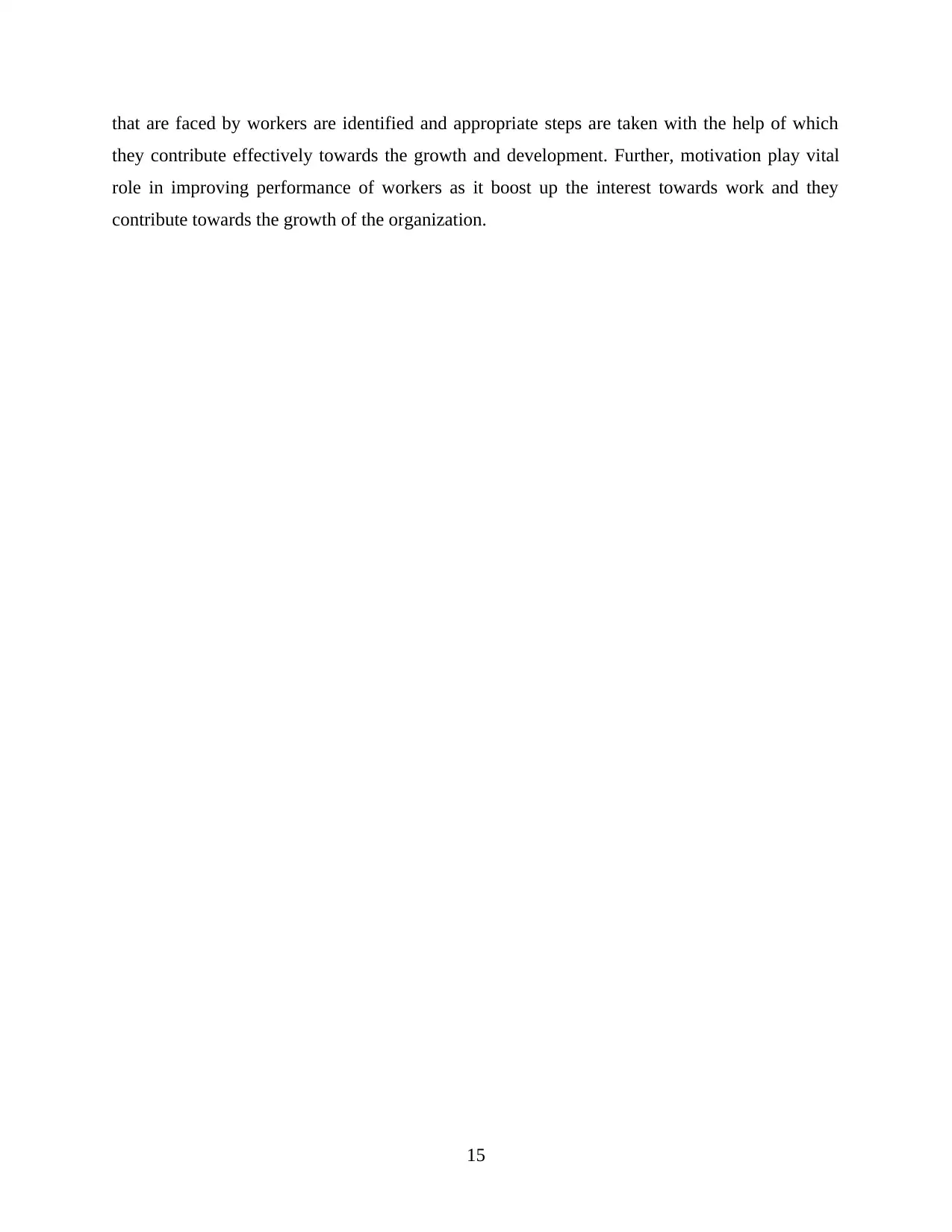
that are faced by workers are identified and appropriate steps are taken with the help of which
they contribute effectively towards the growth and development. Further, motivation play vital
role in improving performance of workers as it boost up the interest towards work and they
contribute towards the growth of the organization.
15
they contribute effectively towards the growth and development. Further, motivation play vital
role in improving performance of workers as it boost up the interest towards work and they
contribute towards the growth of the organization.
15
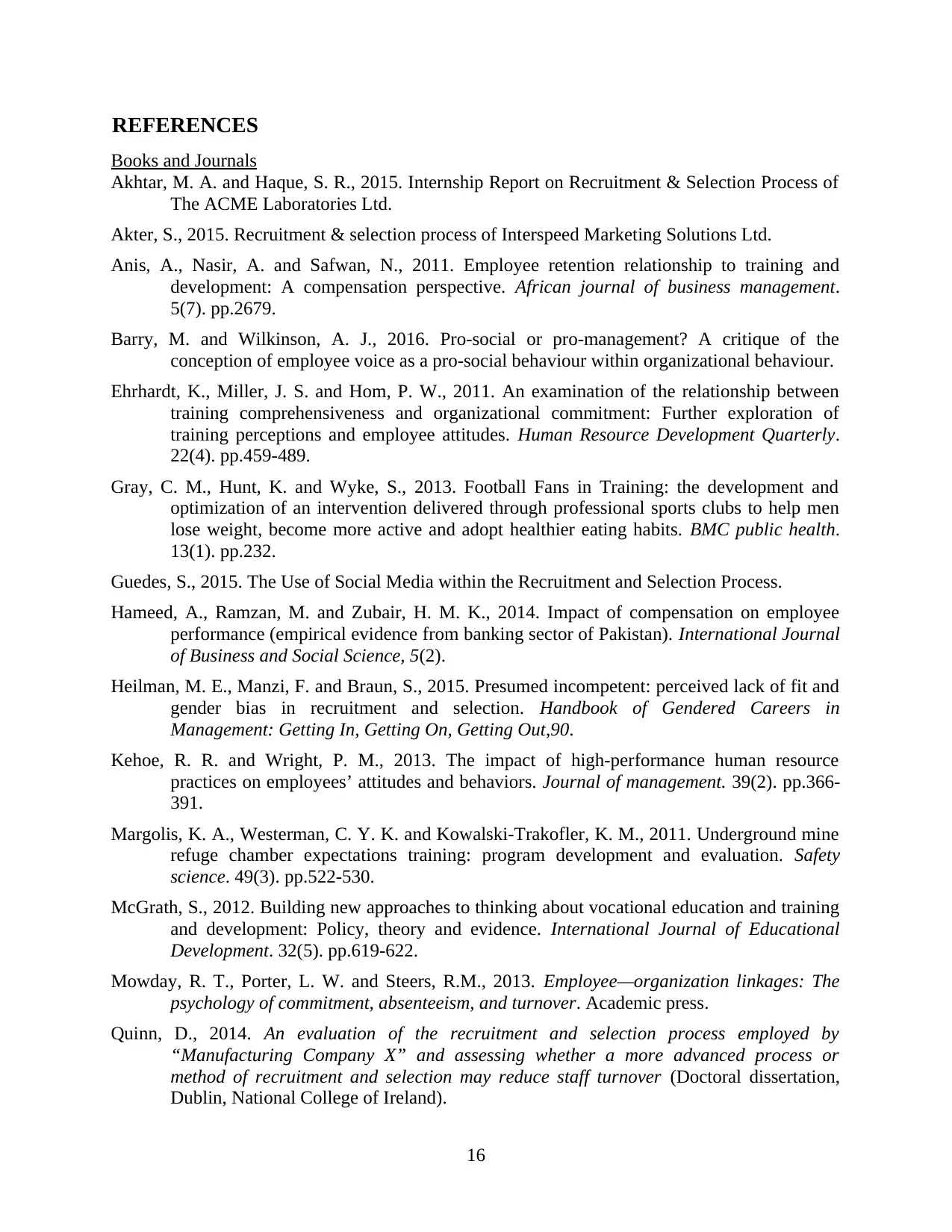
REFERENCES
Books and Journals
Akhtar, M. A. and Haque, S. R., 2015. Internship Report on Recruitment & Selection Process of
The ACME Laboratories Ltd.
Akter, S., 2015. Recruitment & selection process of Interspeed Marketing Solutions Ltd.
Anis, A., Nasir, A. and Safwan, N., 2011. Employee retention relationship to training and
development: A compensation perspective. African journal of business management.
5(7). pp.2679.
Barry, M. and Wilkinson, A. J., 2016. Pro‐social or pro‐management? A critique of the
conception of employee voice as a pro‐social behaviour within organizational behaviour.
Ehrhardt, K., Miller, J. S. and Hom, P. W., 2011. An examination of the relationship between
training comprehensiveness and organizational commitment: Further exploration of
training perceptions and employee attitudes. Human Resource Development Quarterly.
22(4). pp.459-489.
Gray, C. M., Hunt, K. and Wyke, S., 2013. Football Fans in Training: the development and
optimization of an intervention delivered through professional sports clubs to help men
lose weight, become more active and adopt healthier eating habits. BMC public health.
13(1). pp.232.
Guedes, S., 2015. The Use of Social Media within the Recruitment and Selection Process.
Hameed, A., Ramzan, M. and Zubair, H. M. K., 2014. Impact of compensation on employee
performance (empirical evidence from banking sector of Pakistan). International Journal
of Business and Social Science, 5(2).
Heilman, M. E., Manzi, F. and Braun, S., 2015. Presumed incompetent: perceived lack of fit and
gender bias in recruitment and selection. Handbook of Gendered Careers in
Management: Getting In, Getting On, Getting Out,90.
Kehoe, R. R. and Wright, P. M., 2013. The impact of high-performance human resource
practices on employees’ attitudes and behaviors. Journal of management. 39(2). pp.366-
391.
Margolis, K. A., Westerman, C. Y. K. and Kowalski-Trakofler, K. M., 2011. Underground mine
refuge chamber expectations training: program development and evaluation. Safety
science. 49(3). pp.522-530.
McGrath, S., 2012. Building new approaches to thinking about vocational education and training
and development: Policy, theory and evidence. International Journal of Educational
Development. 32(5). pp.619-622.
Mowday, R. T., Porter, L. W. and Steers, R.M., 2013. Employee—organization linkages: The
psychology of commitment, absenteeism, and turnover. Academic press.
Quinn, D., 2014. An evaluation of the recruitment and selection process employed by
“Manufacturing Company X” and assessing whether a more advanced process or
method of recruitment and selection may reduce staff turnover (Doctoral dissertation,
Dublin, National College of Ireland).
16
Books and Journals
Akhtar, M. A. and Haque, S. R., 2015. Internship Report on Recruitment & Selection Process of
The ACME Laboratories Ltd.
Akter, S., 2015. Recruitment & selection process of Interspeed Marketing Solutions Ltd.
Anis, A., Nasir, A. and Safwan, N., 2011. Employee retention relationship to training and
development: A compensation perspective. African journal of business management.
5(7). pp.2679.
Barry, M. and Wilkinson, A. J., 2016. Pro‐social or pro‐management? A critique of the
conception of employee voice as a pro‐social behaviour within organizational behaviour.
Ehrhardt, K., Miller, J. S. and Hom, P. W., 2011. An examination of the relationship between
training comprehensiveness and organizational commitment: Further exploration of
training perceptions and employee attitudes. Human Resource Development Quarterly.
22(4). pp.459-489.
Gray, C. M., Hunt, K. and Wyke, S., 2013. Football Fans in Training: the development and
optimization of an intervention delivered through professional sports clubs to help men
lose weight, become more active and adopt healthier eating habits. BMC public health.
13(1). pp.232.
Guedes, S., 2015. The Use of Social Media within the Recruitment and Selection Process.
Hameed, A., Ramzan, M. and Zubair, H. M. K., 2014. Impact of compensation on employee
performance (empirical evidence from banking sector of Pakistan). International Journal
of Business and Social Science, 5(2).
Heilman, M. E., Manzi, F. and Braun, S., 2015. Presumed incompetent: perceived lack of fit and
gender bias in recruitment and selection. Handbook of Gendered Careers in
Management: Getting In, Getting On, Getting Out,90.
Kehoe, R. R. and Wright, P. M., 2013. The impact of high-performance human resource
practices on employees’ attitudes and behaviors. Journal of management. 39(2). pp.366-
391.
Margolis, K. A., Westerman, C. Y. K. and Kowalski-Trakofler, K. M., 2011. Underground mine
refuge chamber expectations training: program development and evaluation. Safety
science. 49(3). pp.522-530.
McGrath, S., 2012. Building new approaches to thinking about vocational education and training
and development: Policy, theory and evidence. International Journal of Educational
Development. 32(5). pp.619-622.
Mowday, R. T., Porter, L. W. and Steers, R.M., 2013. Employee—organization linkages: The
psychology of commitment, absenteeism, and turnover. Academic press.
Quinn, D., 2014. An evaluation of the recruitment and selection process employed by
“Manufacturing Company X” and assessing whether a more advanced process or
method of recruitment and selection may reduce staff turnover (Doctoral dissertation,
Dublin, National College of Ireland).
16
1 out of 18
Related Documents
Your All-in-One AI-Powered Toolkit for Academic Success.
+13062052269
info@desklib.com
Available 24*7 on WhatsApp / Email
![[object Object]](/_next/static/media/star-bottom.7253800d.svg)
Unlock your academic potential
© 2024 | Zucol Services PVT LTD | All rights reserved.





